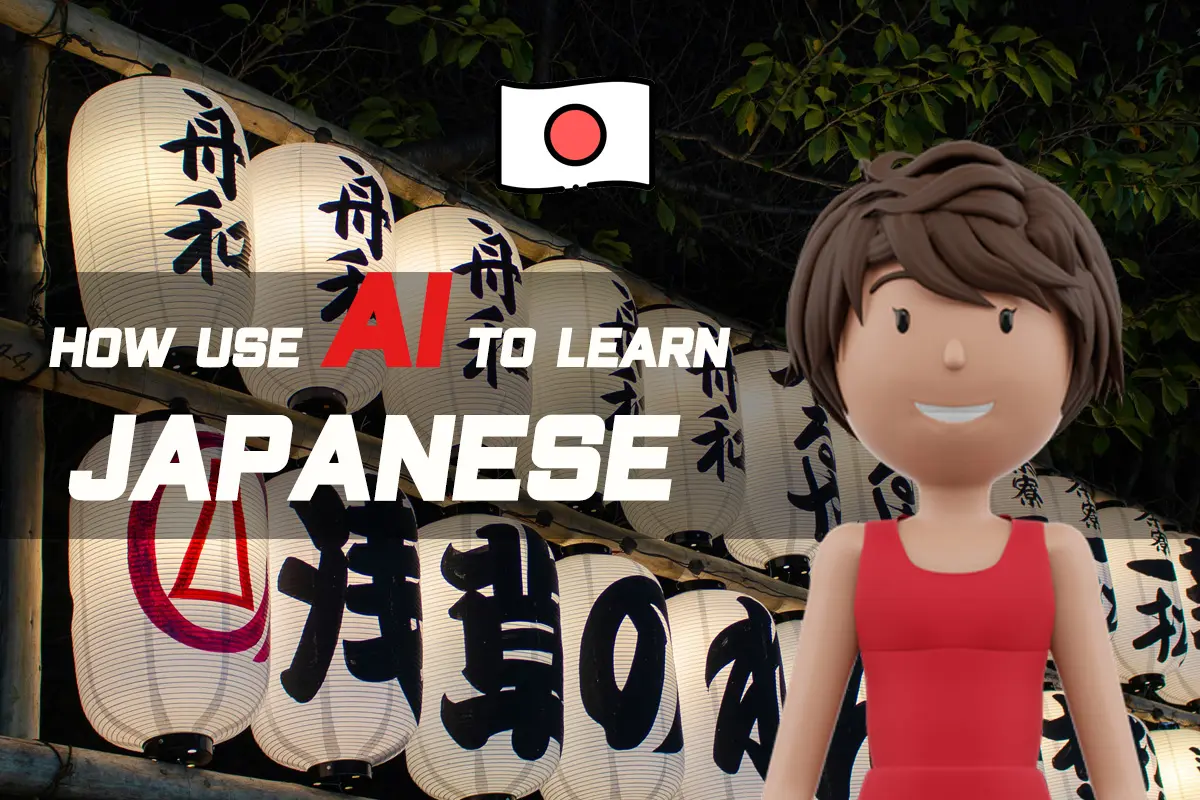
If you’re asking yourself how to learn Japanese with AI, the short answer is this: AI tools now act as personal tutors that help you practice Japanese speaking, listening, reading, and writing anytime, anywhere. From pronunciation trainers that adjust your accent, to conversational bots that role-play real situations, AI makes learning Japanese more interactive, adaptive, and fun than ever before.
In this post, we’ll explore how AI can transform your Japanese learning journey, the best apps and strategies, and why combining AI with cultural immersion is the fastest route to fluency.
1. Why Japanese Is Hard — and How AI Helps
Japanese is often listed as one of the hardest languages for English speakers. Why?
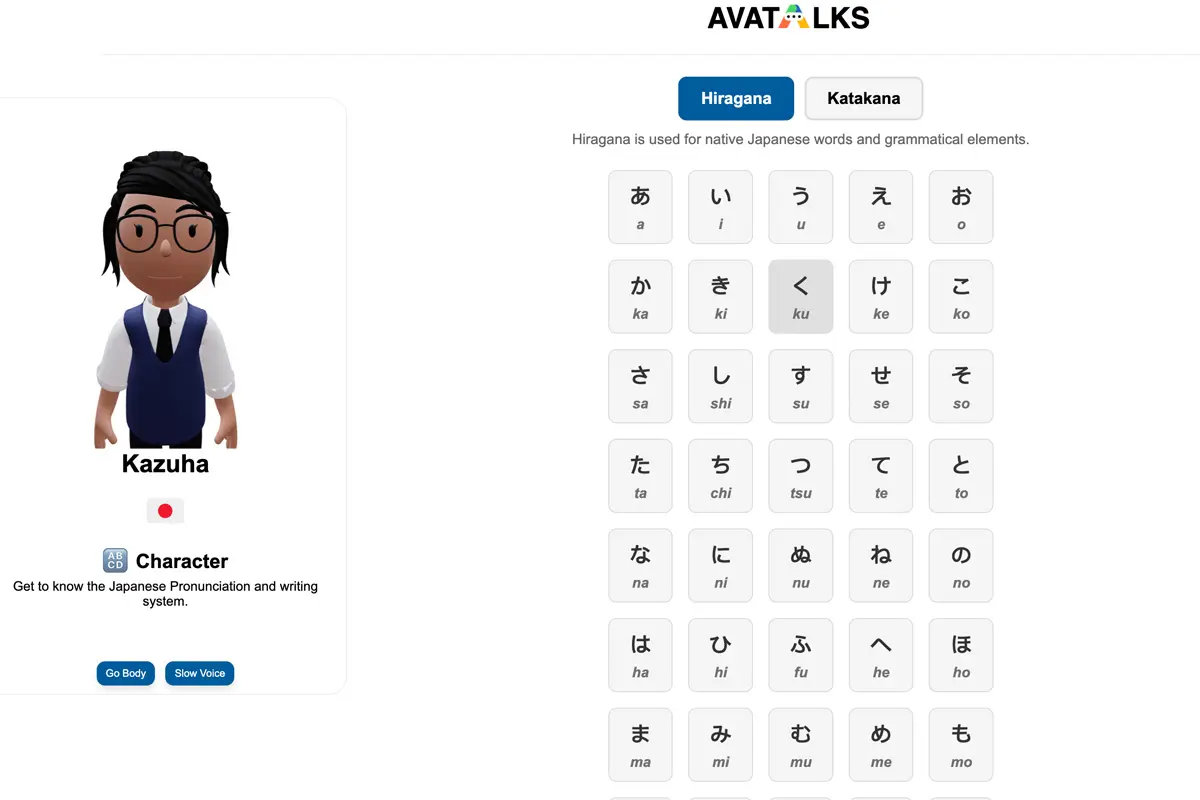
- Three writing systems (Hiragana, Katakana, Kanji).
- Grammar structure (Subject–Object–Verb order).
- Politeness levels (formal, casual, and honorific).
- Vocabulary borrowing (words from Chinese, English, and beyond).
Example:
- konnichiwa こんにちは (hello)
- arigatou gozaimasu ありがとうございます (thank you very much)
For a beginner, switching between writing, speaking, and cultural nuances can feel overwhelming. AI helps by breaking down these challenges into small, personalized steps — giving instant corrections and adapting to your pace.
2. How AI Transforms Language Learning
Traditional methods rely on textbooks or classroom repetition. AI, on the other hand, uses advanced technologies to personalize learning:
- Speech recognition → Corrects pronunciation instantly (e.g., long vs short vowels like obasan vs obaasan).
- Natural Language Processing (NLP) → Understands grammar and sentence structure.
- Text-to-Speech (TTS) → Reads Japanese words aloud with native-like pronunciation.
- Conversation simulation → Lets you role-play real-life situations like ordering sushi or asking for train directions.
- Adaptive learning paths → AI tracks your progress and adjusts difficulty automatically.
💡 Example: You practice saying itadakimasu いただきます. The AI app not only checks pronunciation but also explains the cultural meaning behind saying it before meals.
3. Best AI Tools to Learn Japanese
The most effective way to learn Japanese with AI is by using Avatalks, an interactive platform that brings together all core skills — vocabulary, grammar, listening, reading, and speaking — in one place. Unlike generic apps, Avatalks is designed to simulate real-life conversations and guide learners step by step.
a) Build Japanese Vocabulary
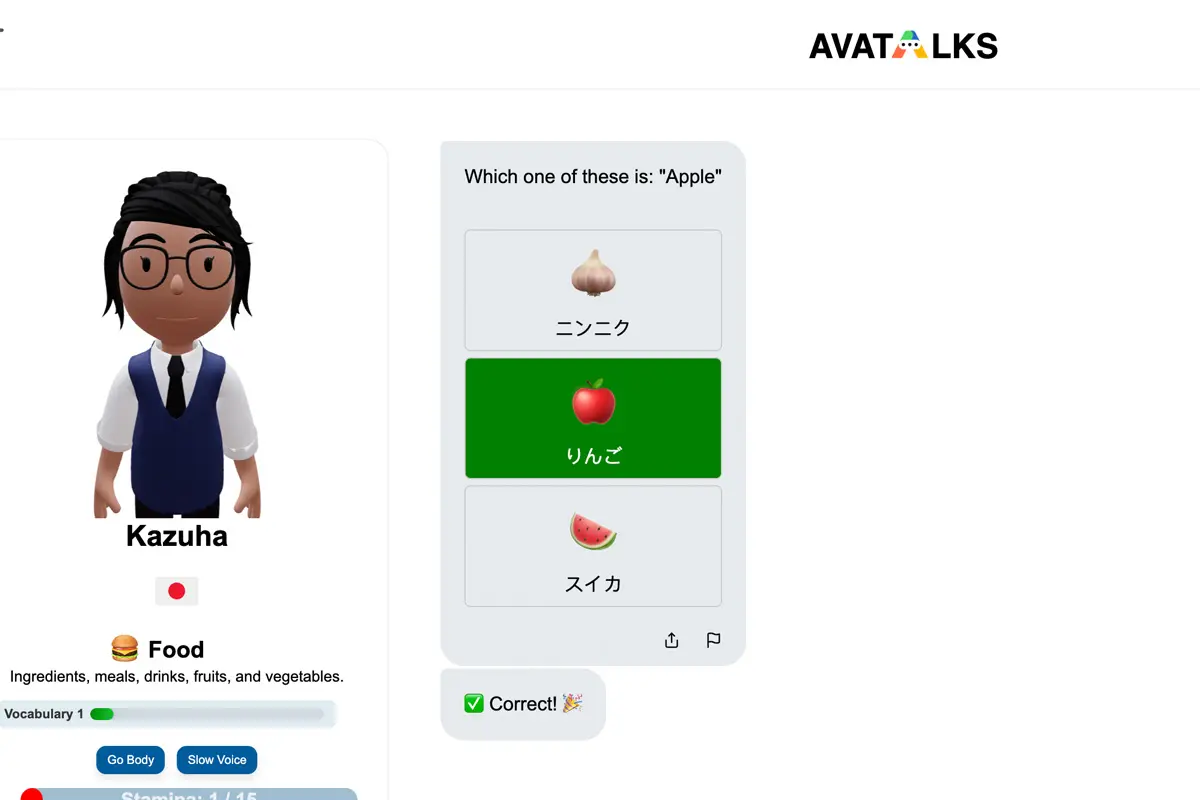
Avatalks introduces words in context with clear translations, example sentences, and AI avatars who use the vocabulary naturally in conversation. Instead of rote memorization, you practice words like neko (cat) or taberu (to eat) in meaningful exchanges, so the terms stick.
b) Master Japanese Grammar
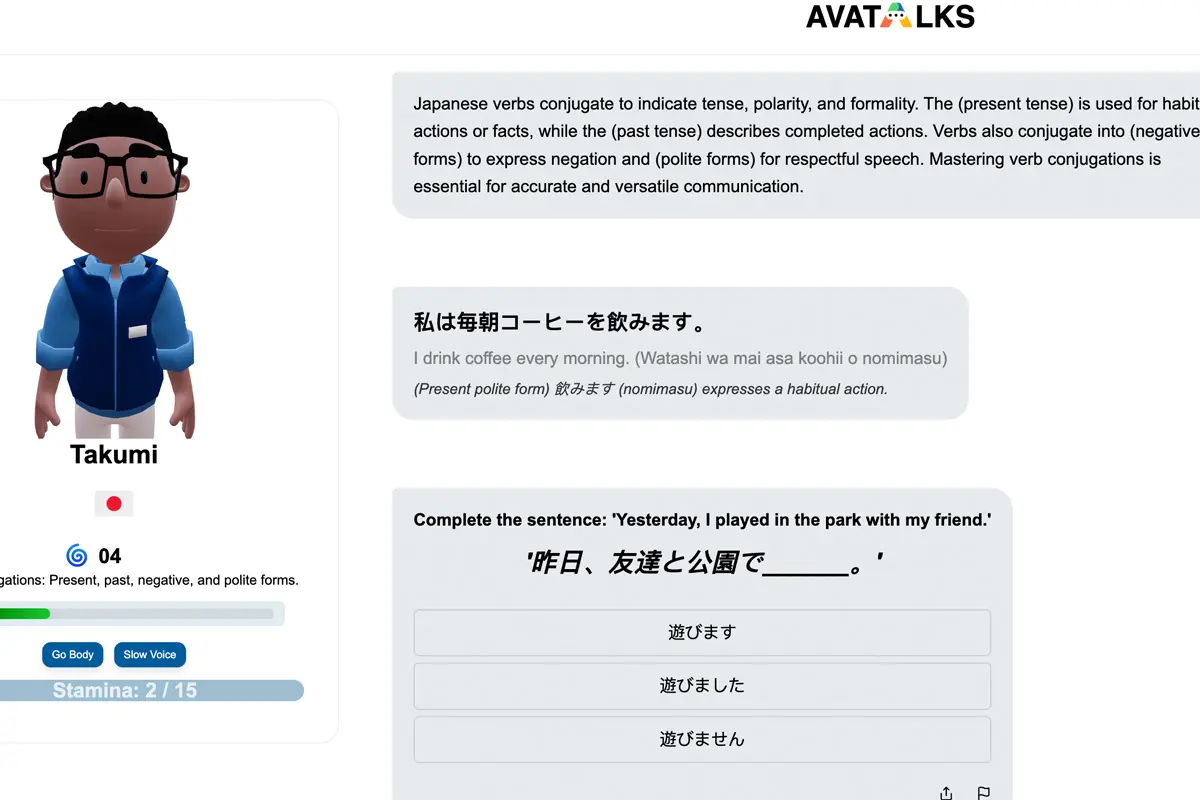
Complex grammar points like particles (は, が, を) or verb conjugations are broken down with examples. Avatalks’ AI characters walk you through sentence-building exercises, showing how to apply grammar in everyday scenarios — from casual chats to polite business contexts.
c) Practice Japanese Listening
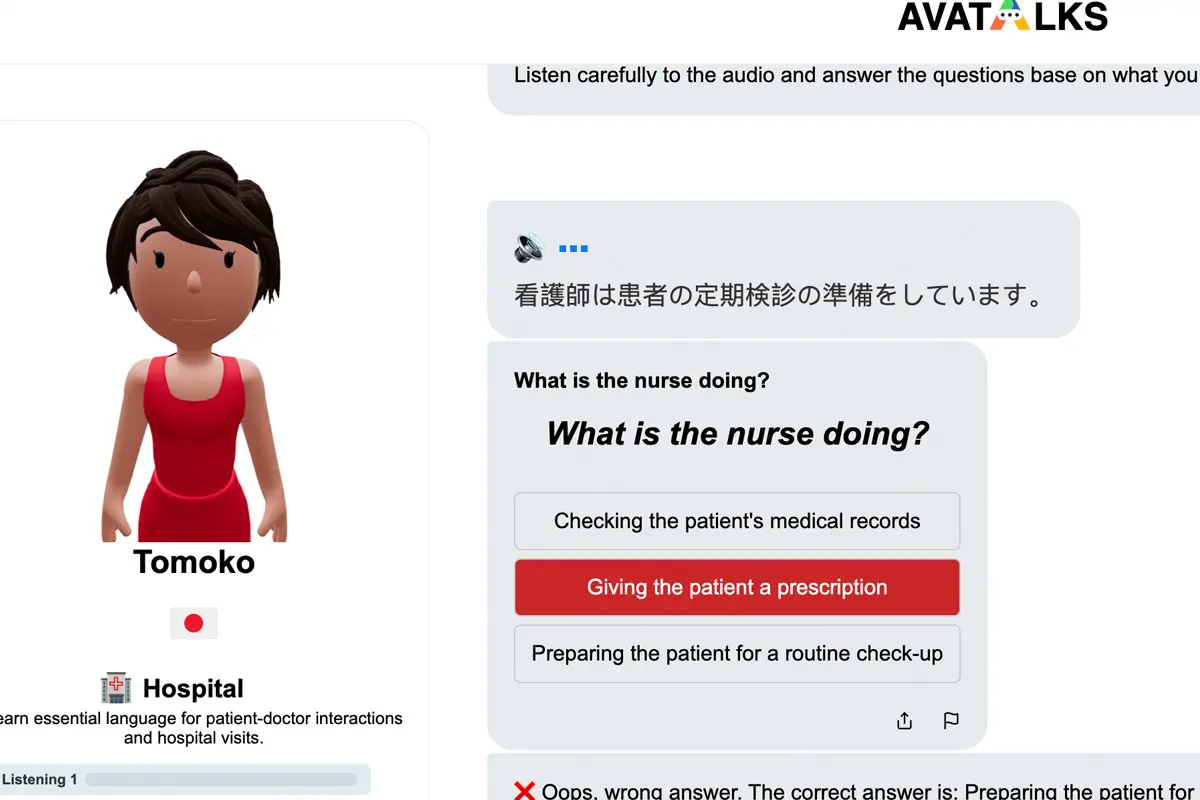
Through AI-powered dialogues, Avatalks lets you hear natural Japanese pronunciation and intonation. You can slow down playback, repeat lines, or jump into role-play conversations. This helps train your ear for common phrases used in daily life, anime, or even travel.
d) Improve Japanese Reading
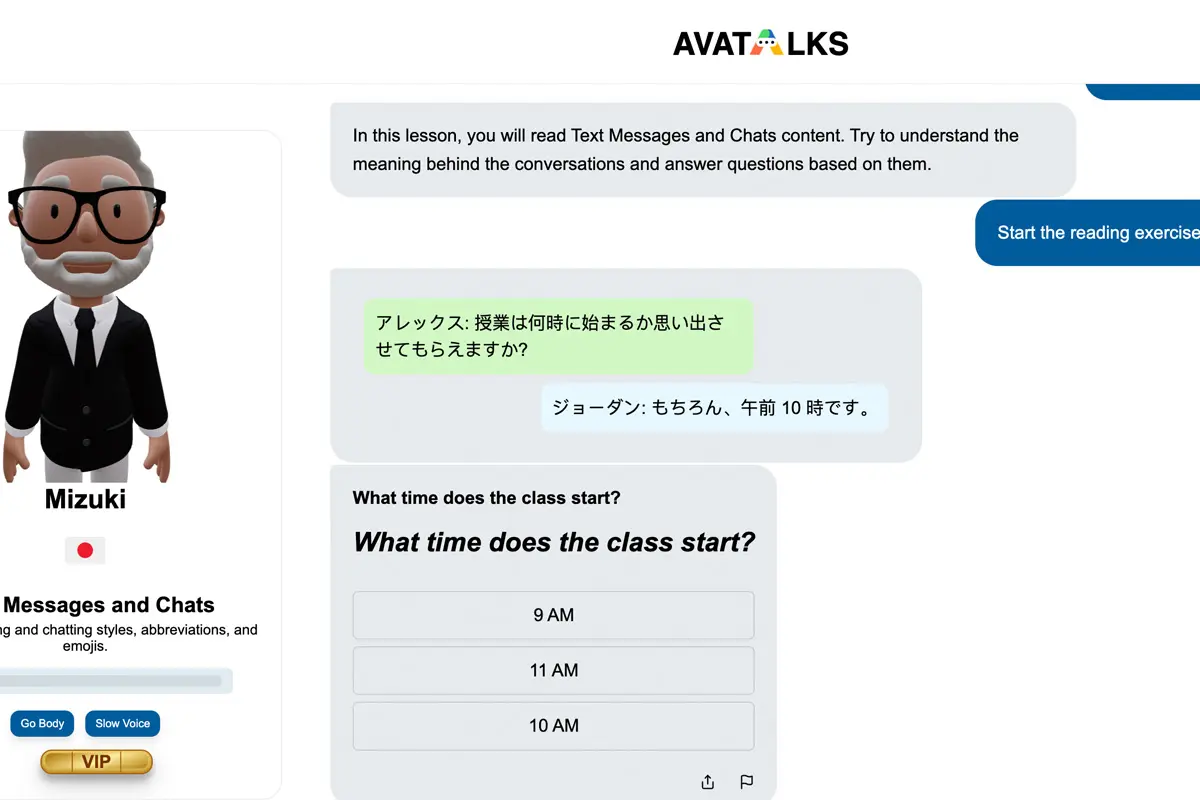
Avatalks offers reading practice with short texts, dialogues, and stories in Japanese. Each word can be clicked for instant translation, letting you read smoothly while expanding vocabulary. Gradually, you move from basic kana sentences to kanji-rich passages.
e) Speak Japanese with Scenario Simulation
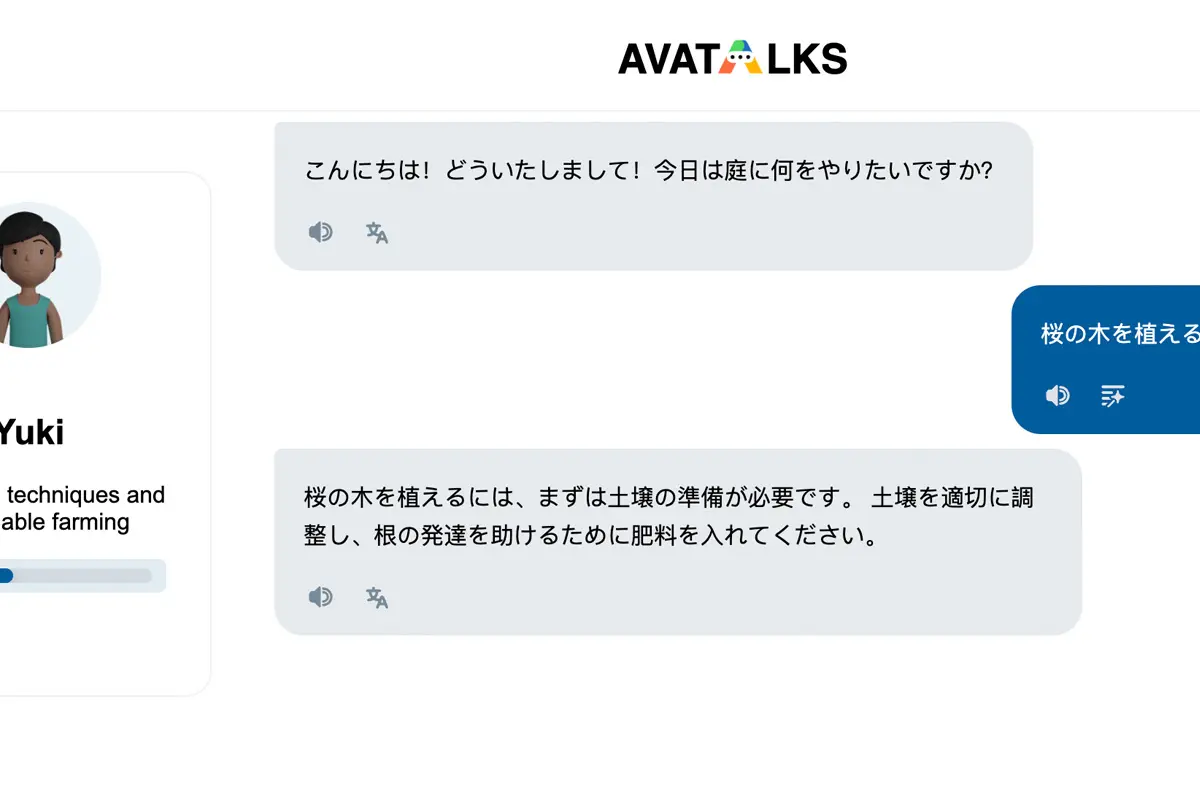
The highlight of Avatalks is scenario-based speaking practice. You can role-play ordering sushi at a Tokyo restaurant, asking for directions at a train station, or introducing yourself at a Japanese workplace. The AI avatars respond in real time, correcting your pronunciation and grammar while keeping the interaction natural.
💡 Pro Tip: Use Avatalks daily for at least 15 minutes. Start with vocabulary and grammar, then move to listening and reading, and finish each session with a speaking simulation. This full-cycle practice accelerates fluency and builds confidence.
4. Core Skills: Speaking, Listening, Reading, Writing
AI supports every major skill:
Speaking
- AI corrects mispronunciations instantly.
- Practice phrases like Sumimasen, eki wa doko desu ka? (Excuse me, where is the station?).
Listening
- Watch anime or dramas with AI-generated subtitles.
- Test comprehension by answering chatbot questions.
Reading
- AI kanji recognition apps break down complex characters.
- Example: Learn the difference between 日 (day/sun) and 月 (month/moon).
Writing
- Handwriting recognition corrects your strokes.
- Practice building sentences with hiragana and kanji.
5. Cultural Insights from AI
Japanese is more than words — it’s culture embedded in language.
AI apps now include:
- Politeness training: Learn when to use arigatou vs arigatou gozaimasu.
- Food and drinks context: Order confidently in restaurants (sushi o kudasai).
- Daily customs: Learn expressions like itadakimasu before meals or otsukaresama after work.
This cultural layer makes your Japanese sound authentic, not just grammatical.
6. AI Tutors vs Human Tutors
| Aspect | AI Tutors | Human Tutors |
|---|---|---|
| Availability | 24/7 | Limited |
| Feedback | Instant | Slower |
| Cultural nuance | Limited | Deep |
| Motivation | Gamified | Personal |
| Cost | Low/free | Higher |
👉 The best strategy? Blended learning: use AI daily, then human tutors for cultural depth and conversation fluency.
7. Step-by-Step Plan: How to Learn Japanese with AI
- Master the basics: Start with Hiragana & Katakana via AI handwriting apps.
- Daily practice: Speak for 15 minutes with an AI avatar.
- Use conversation bots: Practice greetings like konnichiwa and ohayou gozaimasu.
- Track progress: Use AI dashboards to see vocabulary growth.
- Immerse: Watch Japanese YouTube or anime with AI-assisted subtitles.
8. Challenges of AI Learning
AI is powerful, but not perfect:
- May miss slang or regional dialects.
- Lacks emotional depth compared to human teachers.
- Needs internet and device access.
- Can oversimplify cultural subtleties.
That’s why mixing AI and human learning gives the best results.
9. Future of AI in Japanese Learning
Expect exciting developments:
- Custom AI avatars with regional accents.
- AR classrooms that simulate Japanese cities.
- Translation glasses for real-world interactions.
- Emotion-aware AI that adjusts tone and style.
Within a decade, AI may become your full-time language partner.
10. FAQ
Q: Can I become fluent with AI alone?
A: AI helps a lot, but fluency also requires cultural immersion and real conversations.
Q: Which AI app is best?
A: Avatalks for speaking, ELSA for pronunciation, Duolingo for structure.
Q: Is AI better than human tutors?
A: Not better — but faster and cheaper. Combining both works best.
11. Final Thoughts
The smartest way to learn Japanese today is with AI. With personalized apps, 24/7 tutors, and instant feedback, AI makes it easier to practice speaking, improve pronunciation, and understand cultural nuances.
Whether you want to pass the JLPT, travel in Japan, or just enjoy anime without subtitles, AI can be your shortcut to faster, smarter learning.